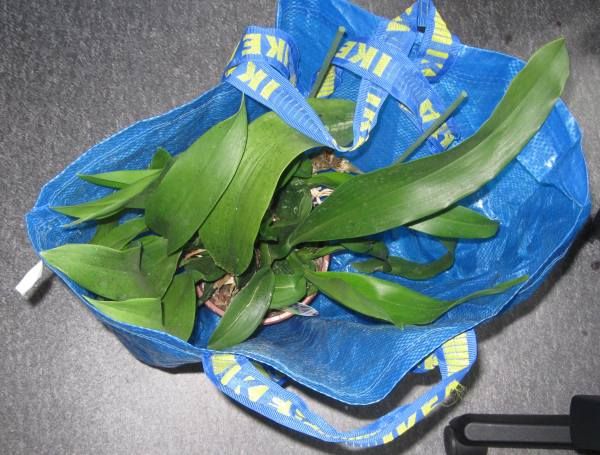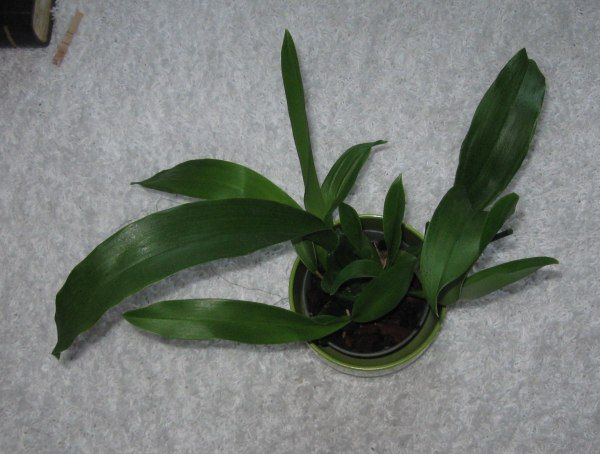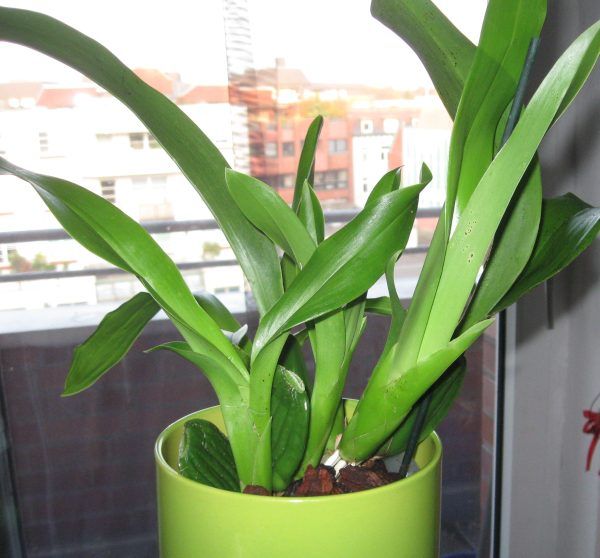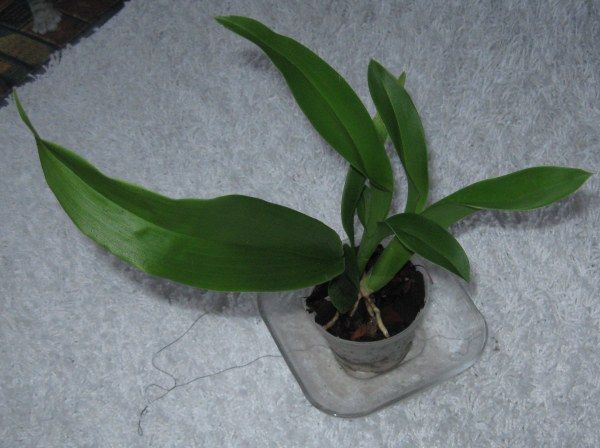Vor einer Woche (letzten Samstag) habe ich eine große Brassia aus dem Baumarkt gerettet, sie stand schon auf dem Sterbetisch. Im Gegensatz zu ihren Leidensgenossen war sie aber nur dehydriert und nicht krank (außer einem ganz leichten Pilzbefall). Und als ich mir sie noch von allen Seiten anguckte – sind da wirklich keine Läuse oder Spinnmilben?! Kamen ein paar andere Kunden angeschossen und schnappten sich die anderen Brassien, die noch geblüht haben- sie haben ihre ganze Kraft in diese (vermutlich letzte) Blüte gesteckt, kaum Neutriebe und teils arg verpilzt. Ich habe dann hin und her überlegt, aber eigentlich sind Brassien ja relativ pflegeleicht und die großen, spinnenartigen Blüten sind schon cool. (Bild von Blüten an Brassia rex) Was für eine Brassia (Hybride?) ich da erwischt habe, kann ich erst sehen, wenn sie wieder blüht, die Blüten an den anderen Pflanzen waren aber zartgrün (Farbe ähnlich einer Limette) und gesprenkelt, also hoffe ich, das es hier ebenso ist.
Also ab in die Tasche damit, wenn sie durchkommt ist das mein bestens Orchideenschnäppchen bisher. (Im Winter hätte ich es nicht gemacht, aber im Sommer kriegt man die Pflanzen in der Regel wieder fit)
Also, hier ist die Kleine (hust, hust), anhand der Ikea-Tasche sieht man die originalen Ausmaße:

Mir war aber klar, das ich dort einiges wegschneiden muss, deshalb freute es mich sehr, dass die Pflanze so stark ist. Nach dem entfernen der verfaulten und sonstigen ungesund aussehenden Bulben und Blätter blieb ein stattlicher Rest über. Hier draußen trocknend nach Behandlung auf Krabbeltiere und Pilze:

Leider sind die Wurzeln nicht alle ok gewesen, weil das Substrat schon in Zerfall und Schimmel übergegangen war – das sie auf dem Sterbetisch kein Wasser mehr bekam, hat ihr das Leben gerettet, denn so wurde der Zerfall im Topf durch das Durchtrocknen gestoppt. Die Pflanze hat sich über den Speicher in ihren Bulben am Leben gehalten.
Nach der Pflege des Wurzelballens, ist die Pflanzen in zwei Teile zerfallen, einen kleinen und einen großen. Da die Wurzeln am kleineren Teil entsprechend kürzer waren, habe ich diesen erstmal separat eingtopft. Er kann ggf. später zurück zur Hauptpflanze.

Der Großteil der Pflanze besteht aus Neutrieben:


Nach einer Woche ist der Pilz nicht vorangeschritten und die Pflanzen sehen straff aus, deshalb denke ich mit vorsichtigen Optimismus, dass beide Teile durchkommen werden. Sie werden auf alle Fälle im Moment nicht getaucht, sondern nur besprüht (aufs Substrat), weil die beschädigten Wurzeln nicht so viel Wasser aufnehmen können. Auch was Licht und Dünger angeht sind sie „auf Diät“.
English Version:
I came past the table of death at Bauhaus and in the backrow were several big pots with a green mess in them- and interesting spidery flowers in pale almost-green, too. Brassias? I snuffled closer. leery to touch any sick plant. There were four Brassias, three were blooming like heck and despite full of blossoms in a state of expiration. The fourth was finished with blooming, rather ruffled, but so big that one might… I pulled it out resolutely and checked it closely- no sign for obvious spidermites. Hmmmm… everything else could possibly be cured or kiiled….Further checking took place, while I tried to check which bulbs were directly connected. I came to the conclusion that those that looked destroyed or heavily damaged would be likely removeable. There were more than ten bulbs afterall. I stood considering, holding the plant, when suddenly some other customers swept up and roughly sorted through the condemned plants in search of a deal. They cowed gleefully and attached to the blooming Brassias, wheeling them off, thinking they had an awesome deal, as the price was greatly discounted.
I chuckled and told the plant that it was coming home with me.
Brassia01 – that is an Ikea-bag, which gives an idea of the plant size.
Brassia02- This was after removing the thouroughly dried out and the one mould covered bulbs.
I removed three more when preparing for pottings, because the way the leaves looked made me suspicious. During the process, the plant divided itself in a big part and small part by breaking on the rhizome on its own. I potted them seperately, because the small part is even likelier to survive.
Brassia03-05 – This is the big part. Some leaves are not very healthy, but it might still make it, because there are a lot rather large new shoots that look better than the older parts of the plant.
Brassia06-07 – The smaller part, theoretically too small, because a part is always supposed to consist of two bulbs, but those two shoots soon will have bulbs and so it counts, I think, LOL!!
The whole plant has a guarded prognosis as has not so good roots (a lot of them are hollow) and it seems have a slight mycosis, but I am gonna treat against this, too and then see. I am optimistic, because if a plant survives such mistreatment in considerably good shape, then obviously it is a strong one.
The substrate had almost turned into soil, so disintegrated it was already, and there was lots of mould in there. I think that the plant was actually saved by ending up on the death table, because if it had been watered, the mould would have eaten it up. Like this, the bulbs ensured the survival and the root-area could fall dry.
After one week I am now more optimistic, because the plants have shown no sign of getting worse and still look proper.
